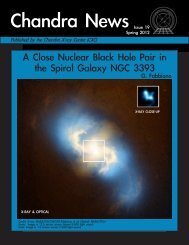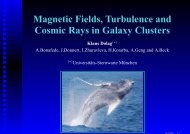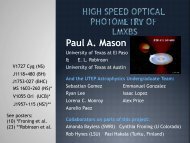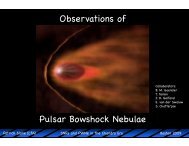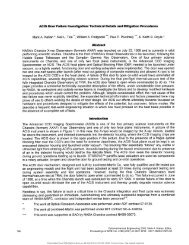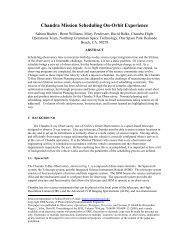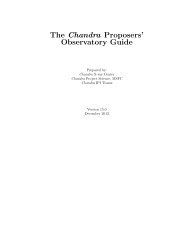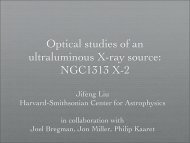observational overview of state transitions in x-ray binaries
observational overview of state transitions in x-ray binaries
observational overview of state transitions in x-ray binaries
Create successful ePaper yourself
Turn your PDF publications into a flip-book with our unique Google optimized e-Paper software.
BACKGROUND<br />
• Known s<strong>in</strong>ce the 1970’s that X-<strong>ray</strong> b<strong>in</strong>aries can show different<br />
spectral <strong>state</strong>s (Cyg X-1, Tananbaum et al. 1972).<br />
• Reflect different modes <strong>of</strong> accretion (<strong>in</strong>flow/outflow)<br />
• mid 1980‘s - early 1990’s: EXOSAT and GINGA. Additional<br />
<strong>state</strong>s identified <strong>in</strong> black hole b<strong>in</strong>aries. Z and atoll classification<br />
for neutron star b<strong>in</strong>aries.<br />
• State dependency <strong>of</strong> rapid X-<strong>ray</strong> variability and radio emission<br />
Let me first start with a little background. Observations <strong>of</strong> the black hole X-<strong>ray</strong> b<strong>in</strong>ary Cyg<br />
X-1 <strong>in</strong> the early 70’s showed that it displayed two dist<strong>in</strong>ct spectral <strong>state</strong>s; a high lum<strong>in</strong>osity<br />
<strong>state</strong> with a s<strong>of</strong>t, thermal X-<strong>ray</strong> spectrum without radio emission, and a low-lum<strong>in</strong>osity <strong>state</strong><br />
with a hard, non-thermal spectrum accompanied with radio emission. The spectral <strong>state</strong>s are<br />
now thought to reflect different modes <strong>of</strong> accretion onto a compact object.<br />
Observations between the mid 80s and early 90‘s with EXOSAT and G<strong>in</strong>ga revealed additional<br />
spectral <strong>state</strong>s <strong>in</strong> black hole X-<strong>ray</strong> b<strong>in</strong>aires and also dist<strong>in</strong>ct spectral <strong>state</strong>s <strong>in</strong> neutron star<br />
sources (with the identification <strong>of</strong> the so-called Z and atoll sources). We also saw the first<br />
<strong>in</strong>dications for a spectral <strong>state</strong> dependency <strong>of</strong> the rapid X-<strong>ray</strong> variability and radio emission.<br />
For the rest <strong>of</strong> the talk I will simply refer to spectral <strong>state</strong>s as <strong>state</strong>s, s<strong>in</strong>ce it is not only the<br />
spectral properties that change.




